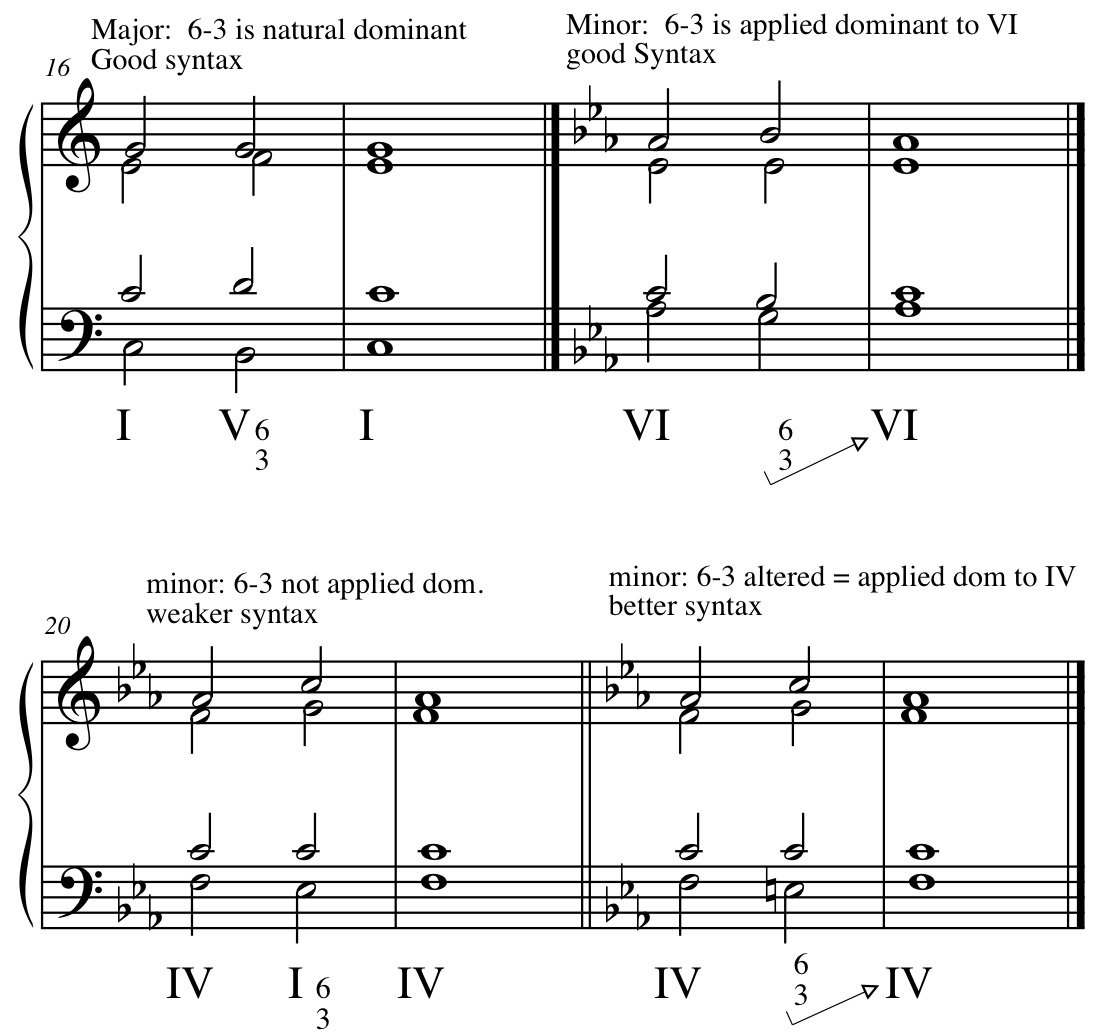Homework: Workbook Chapter 18 p159 -160 #s a,c,e, g,k p161 #2 p162 #3 p164 #1 p167 #3
Homework: Workbook Ed 4 Chapter 19: pg 171-172 a,c, e,g,k 173#1, 179#3
6-3 chords in Parallel Motion
1. Traditional passages in 6-3 chords
a. The use of 6-3 chords dates back to the very early conceptions of vertical harmony. Since, in close position the triad does not contain an interval of a 5th, ¶5ths need not be a concern as they are with parallel 5-3 chords. Extended passages of 6-3 chords tend to lose their individual identity and become somewhat sequential in nature. As such, ¶6-3 chords provide another useful mechanism to bring us from one stable point to another. Like our sequences, they can be used as an effective extended pivot in a modulatory passage. Like sequential passages, when 6-3 chords form a series we need not concern ourselves with syntax except at the very beginning and very end of that series.

2. 6ths between the outter voices
a. The close position of the 6-3 chord, with a 6th above the bass in the soprano, yields a 4th between the Soprano and Alto voice. Hense ¶6-3 chords in close position will yield satisfactory ¶4ths. However if we invert the alto and soprano such that there is a 10th between the soprano and bass, such voicing will yield a 5th between the Soprano and Alto and thus ¶5ths in a series of 6-3 chords with this 10th relation. As such we are mindful of the 6th relationship between the soprano and bass in close or open position.

3. ¶6-3 in 4 voices
a. 4 voice 6-3 chords necessitate a doubling. To avoid ¶8va we allow one of the voices to forego parallel motion and/or alternate doublings within the voices.
b. Both ascending and descending 6-3's are available.

4. Varients of ¶6-3
a. Often a passage with ¶6-3s will depart momentarily from its parallel motion. Often such a break in this pattern will occur for motivic or voice leading considerations. In the example below, the 5-3 chord allows a motivic voice exchange between the Soprano and Alto voices while maintaining a descending stepwise bass..

Other Uses of 6-3 Chords
5. Neighboring 6-3
a. We have seen the Vii6 as a neighbor to I and I6 and we have seen V6 as a neighbor or IN to I. H&VL mentions that a neighboring 6-3 works best when the bass is a half step from the origin.

6. Passing 6-3
a. Like the I-Vii6-I6, V-IV6-V6 and II-PI6-II6 progressions, 6-3 most often connects a root position triad with its first inversion. Sometimes we will see an alteration of a passing 6-3 such that it becomes an applied dominant or an applied Vii6 to the target chord. In these cases remember to make sure the temporary LT exists and that the Vii6 appears as a diminished triad.

b. Variations of the Passing 6-3 include connecting two chords whose bass is a 3rd aparat as in the descending 5-6 sequence.
c. Variations of the Passing 6-3 may include a PV6 in the Phrygian cadence (minor) I-PV6-IV6-V. In such cases the ^5 may sustain as a suspension into IV6.

7. Motion in 3rds
a. H&VL states that very infrequently we see ¶6-3 chords leaping in 3rds for brief periods. It then gives an example that, if analyzed yields a I6-VI6-IV6-II6 progression. It is more important to recognize that this progression works syntactically and since ¶6-3s of any kind present less voice leading obstacles, moves smoothly.
8. "VI6 and "III6" representing I and V
a. We have seen the close relationship between VI6 and I. The 6-5 motion in this progression ties the two chords so closely together that sometimes we see a VI6 acting more as a I chord than a VI chord. This is especially true at the opening of a piece when the initial tonic chord is first being established.
b. Similarly, sometimes we see a chord that appears to be a III6 whose syntax really is that of a V.

c. In minor, when the 6th decorates or substitutes for a 5th over a LT V, an augmented III 6-3 will occur. As with major, this chord's syntax is more of a V than a III.

|

